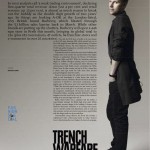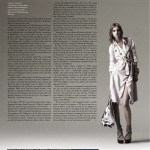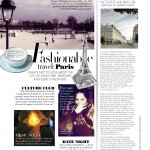Africa’s influence in the fashion industry – Financial Times
A long way from the World Cup epicentres of Johannesburg and Durban, catwalkers in New York and Paris are already marching to an African beat. And why not? If global business will have its eye on all things African this month, chiming with the prevailing mood makes economic as well as sartorial sense.
The work of Nigerian-born, London-based Duro Olowu, for instance, combines vintage couture fabrics and silhouettes with African prints (Princess Caroline of Monaco wore an Olowu evening gown at the Bal de la Rose – an annual event in Monaco attended by the royal family – in March). “What’s interesting,” Olowu says, “is the level of sophistication, which reflects the way African people have always combined European fabrics with indigenous culture. For a long time, there was a sense that this was limited to Africa but now it has become global. Combined with an awareness of social responsibility, it makes for a powerful statement.”
Fashion’s big hitters are interested. Diane von Furstenberg has created a “tribal tattoo desert sugar” wrap dress for summer; Dries Van Noten has used Ikat fabrics from Lamu and Zanzibar with abandon; and Alber Elbaz showed fierce feather and bead neckpieces at Lanvin’s autumn/winter 2010 show in March.
But there is more going on here than simple visual pillaging for mood board inspiration. Elbaz’s work, for example, was inspired by a meeting with United Nations officials to discuss potential projects for the brand in sub-Saharan Africa. As for von Furstenberg, back in March she co-hosted the “Women in the World” summit in New York, which included Hillary Clinton, Meryl Streep and female micro-financing collectives from Nigeria to Liberia.
Increasingly, fashion professionals are making efforts to merge authentic African techniques with high fashion. As Olowu says, “Certain techniques, whether it’s block printing or beading, can’t be faked, and using the real thing gives a garment an integrity recognised by designers and consumers alike.”
One well-known Africa-involved ethical brand is Edun. Its new designer Sharon Wauchob has just returned from her first trip to east Africa. She was struck by “the freshness as far as our industry is concerned. We’ve tried other countries like India for so many trends, but here are crafts that have not been explored in terms of [western] fashion.”
Wauchob hints that the collection to be shown in New York next September will include “metal and beads but something beyond ‘Let’s put these Maasai beads on a T-shirt.’” Meanwhile Edun has launched a mini World Cup line, which includes African-produced T-shirts with a football motif. All proceeds will go to the Conservation Cotton Initiative in Uganda.
Stephanie Hogg, founder of Sierra Leone-based NearFar, believes that “it is possible to create sustainable emplyoment through fusing African creativity with western demand for fashion.” NearFar creates printed playsuits and mini-skirts so enticing that they have been snapped up by cult chain Anthropologie.
Holly Hikido, a former Barneys New York fashion buyer, now commutes between Italy and Addis Ababa to collaborate on a line of featherweight scarves labelled “Sammy Made in Ethiopia”. Her former colleague Julie Gilhart, senior vice-president and fashion director of Barneys, says they are “bestsellers” across the US.
Max Osterweis, who along with ex-Gap designer Erin Beatty runs New York-based, Kenyan-made Suno, agrees. “The idea with Suno is to make clothing covetable enough internationally to provide our tailors in Kenya with long-term employment,” he says.
Michelle Obama is a customer and Carol Lim, of New York’s Opening Ceremony store, is also a fan. “I love Suno because of how the bright colours make me feel,” she says. “It’s kind of like an energy boost.” When customers hear the brand’s made-in-Nairobi story, “it makes the purchase all the more meaningful”, she says.
Helping connect such projects with bigger brands is the Ethical Fashion Programme of the ITC (The International Trade Centre, a joint agency of the World Trade Organisation and the United Nations). Run by Simone Cipriani, a veteran of the Italian fashion world, the programme aims to provide long-term employment under certified fair labour processes for artisans working in impoverished areas.
While the catwalk names getting involved remain under wraps, there are already repeat customers, such as Luisa Laudi, creative director of MAX&Co, a brand of the Max Mara Group aimed at younger customers. “Working with Kenyan craftswomen in the slums is complicated and not like producing accessories in Italy,” she says, “but this is not charity. The accessories are great and in line with our production standards.”
But, Cipriani warns: “If fashion companies don’t fulfil their promises, the damage is severe. There are cases of micro-producers abandoning their own cottage industries to work with outsiders and then it stops and they are also deprived of the little they had before. The result is brutal. They starve.”
The ITC’s long-term projects are designed to mitigate against the damage of Africa going in and then out of fashion. Olowu says: “The world, including the fashion world, is becoming ever-more global. I think the African influence is more than a trend. Now it’s part of the melting pot.”
What to wear between seasons – Financial Times
In the past fortnight, the following shows have taken place in New York: Calvin Klein, Diane von Furstenberg, Yves Saint Laurent, Stella McCartney, Pucci, Céline and Lanvin. A few weeks before that, the latest Chanel and Dior collections were unveiled in St Tropez and Shanghai, respectively.
None of the events was connected to the industry’s biannual fashion weeks – the collections were cruise shows, a between-seasons niche that industry insiders estimate has grown to account for 70 per cent of designers’ annual clothing sales.
The term “cruise” entered fashion vocabulary in the late 1970s, when designers created ready-to-wear holiday wardrobes for wealthy customers who would spend the winter months in the Mediterranean, Florida, or on board cruise ships.
Three decades on, cruise has become such a big money-spinner that there were rumours of Milan and New York vying to claim the concept and stage a “cruise week” in May to rival the ready-to-wear calendar. But last year’s recession hit and it all went quiet. Had the cruise ship sailed?
Not entirely. But it is increasingly clear that cruise shows are entering new territory. Unlike the classic women’s wear shows, which are tied to specific cities, cruise has no such restrictions. A show can be staged where the money is, and in a way best suited to make that money respond.
Take Chanel. It recently held a cruise extravaganza in St Tropez, following shows in Santa Monica and Miami. According to Bruno Pavlovsky, Chanel’s president of fashion: “Travelling is a way to feed the imagination around a brand, and to renew its vision.”
Sidney Toledano, Dior’s chief executive, agrees that holding shows away from conventional venues can be beneficial. “These days, we need to show outside Paris. We needed to do something in China, which is obviously a key market. May is the one month in the year when our teams can travel together, and this presents the perfect opportunity to do a show abroad.” Hence Dior’s lavish show held last month on the Bund in Shanghai, which saw John Galliano tote a vast entourage including a hair and make-up team, models, film stars Marion Cotillard and Charlize Theron, and hatter Stephen Jones, all the way to China.
The Dior collection featured simple day dresses, jaunty stripes, skinny pants and pretty cocktail frocks, all shown with distinctly wearable mid-heel shoes – in other words, clothes that the still-new-to-French-fashion smart Shanghainese could immediately imagine wearing themselves. As Stephen Jones puts it: “People said to me: ‘Are you taking really extraordinary hats?’ but I told them no. Cruise is about hats to take away on holiday. It’s about freshness and simplicity.” And increasing sales of merchandise, from November right through to the following July.
Cruise shows also reveal a company’s strategic direction. Hence brands that have staged big productions in the past, such as Gucci, might choose to go quiet for a season or two. Alternatively, a brand might work on its relationship with its customers – as Valerie Hermann, chief executive of Yves Saint Laurent, which staged a small cruise show in a salon at the French consulate in New York, explains. “We felt it was time to be a little humble,” she says. “Also it was time to be close to the viewers, not up on a pedestal.”
Some in the industry argue that keeping cruise collections off the catwalk altogether can be more advantageous. Tom Chapman, co-owner of Matches, which has 14 stores across London stocking cruise lines from labels such as Stella McCartney and Céline, says: “Because cruise isn’t so exposed, it fills the need for products that are fresh. Think about it. The customer sees Emma Watson walking around in a dress just off the runway that they can’t have for six months. The whole internet frenzy, the fact that fashion images are everywhere, means that consumers have seen ready-to-wear so often, they can lose interest.”
Holli Rogers, buying director at Net-a-Porter, agrees that the attraction of cruise is its newness. “Cruise serves as an indication of next season’s catwalk trends, but in a much more accessible form,” she says.
Indeed, smaller designers, far from lamenting that they can’t afford to stage cruise shows, are relieved to create primarily for their customer rather than catwalk scrutiny. “It’s certainly a calmer process,” says fashion designer Jonathan Saunders. Giles Deacon, who shows his mainline collections in Paris, says that creating his cruise line, which he presents via appointments and a look-book, is “really good fun” and the source of “nice new ideas”.
“In terms of business, it’s the most important season,” says Australian designer Richard Nicoll. “It also allows me to experiment with techniques and themes and to test-drive them from a sales perspective before the ideas for the next show become crystallised. In essence, it reduces my commercial risk.”
According to international brand strategist Pierre Rougier, whose clients include Narciso Rodriguez, Proenza Schouler and Raf Simons, only the biggest fashion houses such as Dior and Chanel can afford really lavish cruise shows. “Few other [brands] have the resources,” he says. “That said, it creates excitement, which is good for the industry as a whole.”



